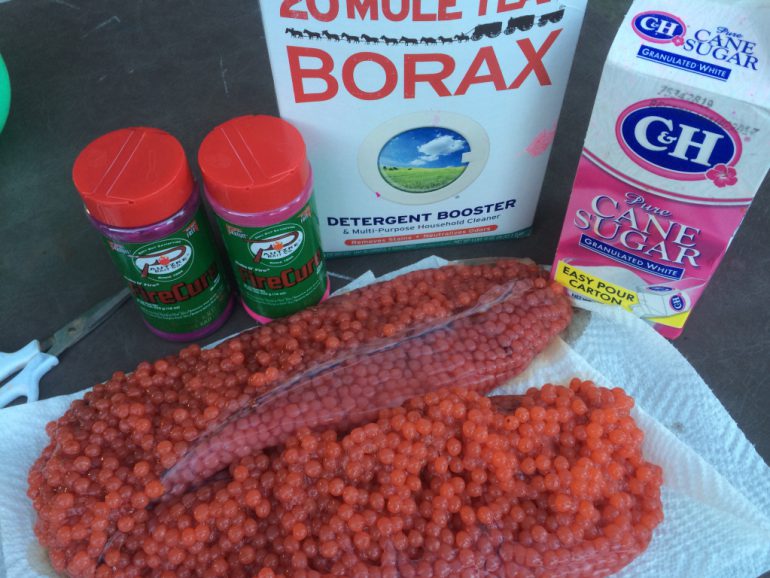I’ve run my shop for over 10 years and have been here since I was fifteen. My physical reflection is now of a man with hair the color of salt and pepper; some call it distinction; some call it the sign of wisdom. I don’t know about either of those things, but I do know it’s mine and I’ll own it the best that I can.
Advertisement
Working off the hope that while I was earning my grey hair I was simultaneously gaining some wisdom, I come to this issue’s article. One of the questions most frequently asked of me, over these many years at the shop, pertains to roe and how to cure it. With the price the market is charging for it, anglers really want to learn to do it themselves. The alternatives to DIY are to pay the high price or to go on a waiting list and patiently wait for second-rate scraps, so I’ll help you learn how to do it yourself.
First, when you catch a doe you need to bleed it correctly, either at the gills or the base of the tail. This allows the blood to leave the fish without coagulating in the roe skeins. If you don’t have a place to store the skeins, leave them inside the fish to protect them from external damage.
Advertisement
I also bleed the skeins. I make a few incisions on the skein veins and push the blood out with my thumbnail. This slows down the decomposition of the eggs. You’ll know your eggs are decomposing if you smell a bad, sour odor.
Once they’ve been bled, rinse them off with river water. River water is truly the best for them; tap water, which has chlorine in it, is the worst and, in my humble and grey-haired opinion, it taints the roe.
Advertisement
From this point on I only handle them with nitrate gloves, ensuring that my scent is not transferred to the roe. A fish’s olfactory sense, especially sturgeon, is extremely acute. Fresh non-cured roe is one of the best baits to use for sturgeon during a peak salmon run. In this stage the roe is as good as gold and can mean the difference between two and 20 fish to hand.
I never freeze my roe first and then cure it later; that’s the worst thing you can do to it. When roe freezes, it produces ice particles inside the eggs that pierce the eggs and let out all the nourishment and precious scent. The skeins should only be frozen once they are cured.
There are many ways to cure the skeins of your salmon or steelhead, most are sulphite based such as Procure but there is also Borax for a more natural base. Borax is my favourite. Regardless of which product you choose, you must cure your eggs as quickly as possible, before your roe starts to decompose.
If you chose Procure, my advice is to use the jar method. As you sprinkle procure on your eggs, be certain to use it sparingly as it can burn your eggs. This process creates a liquid that, through osmosis, gets absorbed back into the eggs and cures them. The most popular color is Red Hot Double and they now have a pretty awesome UV product, available in a rainbow of colors.
I’m meticulous; I take considerable care to make the most perfect roe. I start by drying them on racks in a cool dry place and use a fan to help circulate air. I turn them frequently for six to eight hours. At the beginning of the drying process I sprinkle equal parts sea salt or a non-iodized salt, white sugar and garlic, yes, garlic! This mixture adds a superior strength and sheen to my eggs and the scent drives the fish wild. It is time to remove the eggs from the racks once they become tacky. Pay close attention to this part, making sure that the moisture has been removed from the eggs ensures that once the Borax is applied it doesn’t take on the consistency of jam. I love working with Borax because it’s all natural and sulfite free. I sometimes add color to the Borax and sometimes keep it natural. To color my eggs I use Kool-Aid in pink (watermelon), red (cherry) or chartreuse (a combo of lemon-lime and orange). Add the Kool-Aid crystals (dry) to the Borax in small amounts until you achieve your desired color. A little goes a long way.
I pour the Borax on a big baking sheet first and then lay the skeins down on top, sifting the Borax into the egg flaps, separating each one individually, making sure the cure gets into each fold. Once this is done, your eggs are complete. You’ll have made your own quality roe that performs well, drift after drift, properly milking and letting out an irresistible scent while keeping its consistency, meaning more time fishing in the water and less bait changes.
Butcher’s paper (not freezer paper) or non-colored newspaper are best to wrap the cured roe in. I use Butcher’s paper and then Kryovac (or use a freezer Ziploc, ensuring all the air has been expelled from the bag) each skein separately so that I can give small amounts to my closest friends and customers. Each individually wrapped skein package is made meticulously, with a love of the process and an even greater love of what these hand-cured packages of quality roe will bring–which is lots of fish.
